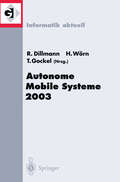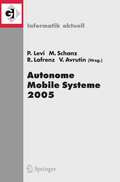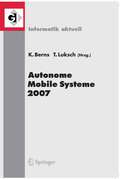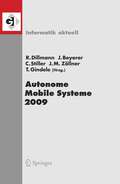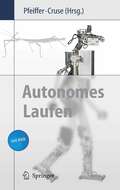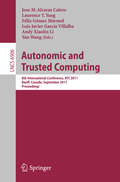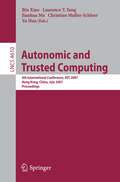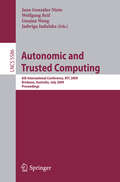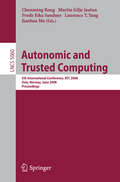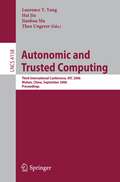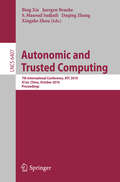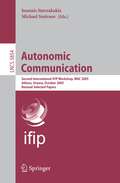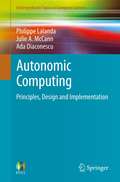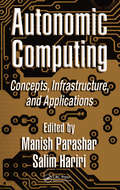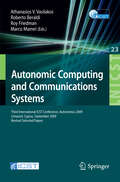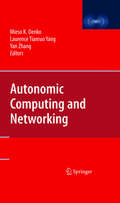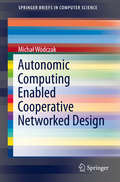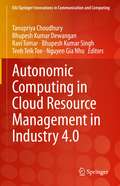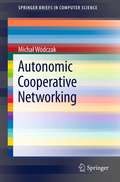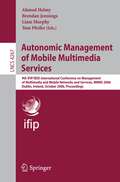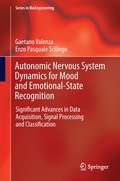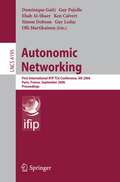- Table View
- List View
Autonome Mobile Systeme 2003: 18. Fachgespräch Karlsruhe, 4./5. Dezember 2003 (Informatik aktuell)
by Rüdiger Dillmann Heinz Wö Tilo GockelDas 18. Fachgespräch "Autonome Mobile Systeme (AMS 2003)" ist ein Forum, in dem die neuesten Entwicklungen auf dem Gebiet wissenschaftlicher und industrieller autonomer Robotersysteme vorgestellt werden. Die Beiträge zu den Schwerpunkten Autonome Systeme im Straßenverkehr, Autonome und kooperative Systeme, Industrielle Systeme, Flug- und Unterwassersysteme, Bildverarbeitung, Planungsverfahren, Anwendungen und ihr Einsatz in Fertigung, Service, Reinigung, Entertainment, Infotainment und Edutainment, sowie Verhaltensbasierte KI u.a. bilden den Inhalt dieses Bandes.
Autonome Mobile Systeme 2005: 19. Fachgespräch Stuttgart, 8./9. Dezember 2005 (Informatik aktuell)
by Paul Levi Michael Schanz Reinhard Lafrenz Viktor AvrutinDas 19. Fachgespräch Autonome Mobile Systeme (AMS 2005) ist ein Forum, das Wissenschaftlerinnen und Wissenschaftlern aus Forschung und Industrie, die auf dem Gebiet der autonomen mobilen Systeme arbeiten, eine Basis für den Gedakenaustausch bietet und wissenschfltiche Diskussionen sowie Kooperationen auf diesem Forschungsgebiet fördert bzw. initiiert. Ausgewählte Beiträge zu den Themen Kooperative Systeme, Bildverarbeitung, Lokalisierung und Kartographierung, Outdoor-Systeme, Fahrerassistenzsysteme, Kognitive Sensordatenverarbeitung, Architekturen und Anwendungen sowie Steuerung und Navigation bilden den Inhalt dieses Bandes.
Autonome Mobile Systeme 2007: 20. Fachgespräch Kaiserslautern, 18./19. Oktober 2007 (Informatik aktuell)
by Karsten Berns Tobias LukschAusgewählte Beiträge zu aktuellen Themen: Das 20. Fachgespräch Autonome Mobile Systeme (AMS 2007) ist ein Forum für Wissenschaftler/innen aus Forschung und Industrie, die auf dem Gebiet der autonomen mobilen Systeme arbeiten. Es bietet Raum für Gedankenaustausch und Diskussion und fördert bzw. initiiert Kooperationen auf diesem Forschungsgebiet. Das diesjährige Fachgespräch beschäftigt sich hauptsächlich mit dem Bereich der kognitiven Automobile und Laufmaschinen.
Autonome Mobile Systeme 2009: 21. Fachgespräch Karlsruhe, 3./4. Dezember 2009 (Informatik aktuell)
by Marius Zöllner Tobias Gindele Rüdiger Dillmann Jürgen Beyerer Christoph StillerDer Band dokumentiert das 21. Fachgespräch Autonome Mobile Systeme (AMS 2009). Die Veranstaltung bietet Wissenschaftlern aus Forschung und Industrie ein Forum für den Gedankenaustausch und eine Basis, um Kooperationen auf diesem Forschungsgebiet zu initiieren. Die Beiträge befassen sich mit Themen wie humanoide Roboter und Flugmaschinen, Perzeption und Sensorik, Kartierung und Lokalisation, Regelung, Navigation, Lernverfahren, Systemarchitekturen sowie mit der Anwendung von autonomen mobilen Systemen.
Autonomes Laufen
by Friedrich Pfeiffer Holk CruseLaufen ist eine der genialsten Erfindungen der Natur. Aber erst in neuerer Zeit haben sich Technologien entwickelt, die den erfolgreichen Bau von autonomen Laufmaschinen realistisch erscheinen lassen. Dieses Buch beinhaltet die Ergebnisse des DFG Schwerpunktprogramms SPP1039 "Autonomes Laufen" – entstanden aus einer intensiven Zusammenarbeit einiger der führenden Ingenieure, Biologen und Informatiker auf diesem Gebiet. Es werden technische Realisierungen von Laufmaschinen ebenso präsentiert wie neueste biologische Erkenntnisse, deren Ergebnisse unmittelbar in solche technischen Umsetzungen einfließen. Dazu gehören Probleme der topologischen Strukturen des Laufens, der zum Laufen notwendigen Regelungen und Steuerungen und den damit verbundenen Fragen der Sensoren und der Aktoren, die Modellierung der Dynamik sowie die Auslegung und der Bau von Laufmaschinen. Eine dazugehörende und professionell umgesetzte DVD gibt einen vergnüglichen Überblick der Forschungsergebnisse und der dahinter stehenden Probleme.
Autonomic and Trusted Computing: 8th International Conference, ATC 2011, Banff, Canada, September 2-4, 2011, Proceedings (Lecture Notes in Computer Science #6906)
by Jose M. Alcaraz Calero Laurence T. Yang Felix Gomez-Marmol Luis Javier García Villalba Andy Xiaolin Li Yan WangThis book constitutes the refereed proceedings of the 8th International Conference on Autonomic and Trusted Computing, ATC 2011, held in Banff, Canada, September 2011. The 17 revised full papers presented together with 1 keynote speech were carefully reviewed and selected from numerous submissions. The papers address all current issues in autonomic architectures, models and systems, autonomic communications, trusted and secure computing, reliable, secure and trust applications.
Autonomic and Trusted Computing: 4th International Conference, ATC 2007, Hong Kong, China, July 11-13, 2007, Proceedings (Lecture Notes in Computer Science #4610)
by Yu Hua Bin Xiao Laurence T. Yang Christian Muller-SchloerNo fewer than 55 revised full papers are presented in this volume, all given at the 4th International Conference on Autonomic and Trusted Computing, held in Hong Kong, China in July 2007. The papers, presented together with one keynote lecture, were carefully reviewed and selected from 223 submissions. The papers are organized in topical sections on, among others, cryptography and signatures, autonomic computing and services, and secure and trusted computing.
Autonomic and Trusted Computing: 6th International Conference, ATC 2009 Brisbane, Australia, July 7-9, 2009 Proceedings (Lecture Notes in Computer Science #5586)
by Jadwiga Indulska Juan González Nieto Guojun Wang Wolfgang ReifAutonomic and Trusted Computing: 5th International Conference, ATC 2008, Oslo, Norway, June 23-25, 2008, Proceedings (Lecture Notes in Computer Science #5060)
by Chunming Rong Martin Gilje Jaatun Frode Eika Sandnes Laurence Tianruo YangThis book constitutes the refereed procedings of the 5th International Conference on Autonomic and Trusted Computing, ATC 2008, held in Oslo, Norway, in June 2008, co-located with UIC 2008, the 5th International Conference on Ubiquitous Intelligence and Computing. The 25 revised full papers presented together with 26 special session papers and 1 keynote talk were carefully reviewed and selected from 75 submissions. The regular papers are organized in topical sections on intrusion detection, trust, trusted systems and crypto, autonomic computing, organic computing, knowledge and patterns, and pervasive systems. The special session papers cover issues such as organic computing, trust, trust and dependable systems, routing and reliable systems, sensor networks, VoIP, and watermarking.
Autonomic and Trusted Computing: Third International Conference, ATC 2006, Wuhan, China, September 3-6, 2006 (Lecture Notes in Computer Science #4158)
by Laurence T. Yang Hai Jin Theo UngererThis book constitutes the refereed proceedings of the Third International Conference on Autonomic and Trusted Computing, ATC 2006, held in Wuhan, China in September 2006. The 57 revised full papers presented together with two keynotes were carefully reviewed and selected from 208 submissions. The papers are organized in topical sections.
Autonomic and Trusted Computing: 7th International Conference, ATC 2010, Xi'an, China, October 26-29, 2010, Proceedings (Lecture Notes in Computer Science #6407)
by DaQing Zhang Xingshe Zhou Bing Xie Juergen Branke S. Masoud SadjadiComputing systems including hardware, software, communication, and networks are becoming increasingly large and heterogeneous. In short, they have become - creasingly complex. Such complexity is getting even more critical with the ubiquitous permeation of embedded devices and other pervasive systems. To cope with the growing and ubiquitous complexity, autonomic computing (AC) focuses on self-manageable computing and communication systems that exhibit self-awareness, self-configuration, self-optimization, self-healing, self-protection and other self-* properties to the maximum extent possible without human intervention or guidance. Organic computing (OC) additionally addresses adaptability, robustness, and c- trolled emergence as well as nature-inspired concepts for self-organization. Any autonomic or organic system must be trustworthy to avoid the risk of losing control and retain confidence that the system will not fail. Trust and/or distrust relationships in the Internet and in pervasive infrastructures are key factors to enable dynamic interaction and cooperation of various users, systems, and services. Trusted/ trustworthy computing (TC) aims at making computing and communication systems––as well as services––available, predictable, traceable, controllable, asse- able, sustainable, dependable, persistent, security/privacy protectable, etc. A series of grand challenges exists to achieve practical autonomic or organic s- tems with truly trustworthy services. Started in 2005, ATC conferences have been held at Nagasaki (Japan), Vienna (Austria), Three Gorges (China), Hong Kong (China), Oslo (Norway) and Brisbane (Australia). The 2010 proceedings contain the papers presented at the 7th International Conference on Autonomic and Trusted Computing (ATC 2010), held in Xi’an, China, October 26–29, 2010.
Autonomic Communication (Lecture Notes In Physics #Vol. 51)
by Stamatis Karnouskos Manish Parashar Witold Pedrycz Athanasios V. VasilakosNew paradigms for communication/networking systems are needed in order to tackle the emerging issues such as heterogeneity, complexity and management of evolvable infrastructures. In order to realize such advanced systems, approaches should become task- and knowledge-driven, enabling a service-oriented, requirement, and trust-driven development of communication networks. The networking and seamless integration of concepts, technologies and devices in a dynamically changing environment poses many challenges to the research community, including interoperability, programmability, management, openness, reliability, performance, context awareness, intelligence, autonomy, security, privacy, safety, and semantics. This edited volume explores the challenges of technologies to realize the vision where devices and applications seamlessly interconnect, intelligently cooperate, and autonomously manage themselves, and as a result, the borders of virtual and real world vanish or become significantly blurred.
Autonomic Communication: First International IFIP Workshop, WAC 2004, Berlin, Germany, October 18-19, 2004, Revised Selected Papers (Lecture Notes in Computer Science #3457)
by Michael SmirnovThe ?rst IFIP Workshop on Autonomic Communication (WAC 2004) was held 18–19 October 2004 in Berlin, Germany. The workshop was organized by Fra- hofer FOKUS with the help of partners of the EU-funded Autonomic Com- nication Coordination Action — IST-6475 (ACCA), and under technical sp- sorship of IFIP WG6. 6 — Management of Networks and Distributed Systems. The purpose of this workshop was to discuss Autonomic Communication—a new communication paradigm to assist the design of the next-generation n- works. WAC 2004 was explicitly focused on the principles that help to achieve purposeful behavior on top of self-organization (self-management, self-healing, self-awareness, etc. ). The workshop intended to derive these common principles from submissions that study network element’s autonomic behavior exposed by innovative (cross-layer optimized, context-aware, and securely programmable) protocol stack (or its middleware emulations) in its interaction with numerous, often dynamic network groups and communities. The goals were to understand how autonomic behaviors are learned, in?uenced or changed, and how, in turn, these a?ect other elements, groups and the network. The highly interactive and exploratory nature of WAC 2004 de?ned its format — six main sessions grouped in three blocks, each block followed by a panel with all speakers of the previous block as panellists and session chairs as panel moderators. The?rstpanelaimedtohighlightthemainprinciplesguidingresearchinal- rithms,protocolsandmiddleware;thesecondpanelinvestigatedgrandchallenges of network and service composition; the third panel had to answer the question “HowDoestheAutonomicNetworkInteractwiththeKnowledgePlane?”. Panel reports were compiled by panel moderators and conclude this volume.
Autonomic Communication: Second International IFIP Workshop, WAC 2005, Athens, Greece, October 2-5, 2005, Revised Selected Papers (Lecture Notes in Computer Science #3854)
by Ioannis Stavrakakis Michael SmirnovThis book constitutes the thoroughly refereed post-proceedings of the Second International IFIP Workshop on Autonomic Communication, WAC 2005, held in Athens, Greece in October 2005. The 22 revised full papers presented together with one keynote paper, three invited papers and two panel summaries were carefully selected during two rounds of reviewing and improvement from numerous submissions. The papers discuss the principles of Autonomic Communication (AC).
Autonomic Computing: Principles, Design and Implementation (Undergraduate Topics in Computer Science)
by Philippe Lalanda Julie A. McCann Ada DiaconescuThis textbook provides a practical perspective on autonomic computing. Through the combined use of examples and hands-on projects, the book enables the reader to rapidly gain an understanding of the theories, models, design principles and challenges of this subject while building upon their current knowledge. Features: provides a structured and comprehensive introduction to autonomic computing with a software engineering perspective; supported by a downloadable learning environment and source code that allows students to develop, execute, and test autonomic applications at an associated website; presents the latest information on techniques implementing self-monitoring, self-knowledge, decision-making and self-adaptation; discusses the challenges to evaluating an autonomic system, aiding the reader in designing tests and metrics that can be used to compare systems; reviews the most relevant sources of inspiration for autonomic computing, with pointers towards more extensive specialty literature.
Autonomic Computing: Concepts, Infrastructure, and Applications
by Manish Parashar and Salim HaririThe complexity of modern computer networks and systems, combined with the extremely dynamic environments in which they operate, is beginning to outpace our ability to manage them. Taking yet another page from the biomimetics playbook, the autonomic computing paradigm mimics the human autonomic nervous system to free system developers and administrators from performing and overseeing low-level tasks. Surveying the current path toward this paradigm, Autonomic Computing: Concepts, Infrastructure, and Applications offers a comprehensive overview of state-of-the-art research and implementations in this emerging area.This book begins by introducing the concepts and requirements of autonomic computing and exploring the architectures required to implement such a system. The focus then shifts to the approaches and infrastructures, including control-based and recipe-based concepts, followed by enabling systems, technologies, and services proposed for achieving a set of "self-*" properties, including self-configuration, self-healing, self-optimization, and self-protection. In the final section, examples of real-world implementations reflect the potential of emerging autonomic systems, such as dynamic server allocation and runtime reconfiguration and repair.Collecting cutting-edge work and perspectives from leading experts, Autonomic Computing: Concepts, Infrastructure, and Applications reveals the progress made and outlines the future challenges still facing this exciting and dynamic field.
Autonomic Computing: Concepts, Infrastructure, and Applications
by Manish Parashar Salim HaririThe complexity of modern computer networks and systems, combined with the extremely dynamic environments in which they operate, is beginning to outpace our ability to manage them. Taking yet another page from the biomimetics playbook, the autonomic computing paradigm mimics the human autonomic nervous system to free system developers and administrators from performing and overseeing low-level tasks. Surveying the current path toward this paradigm, Autonomic Computing: Concepts, Infrastructure, and Applications offers a comprehensive overview of state-of-the-art research and implementations in this emerging area.This book begins by introducing the concepts and requirements of autonomic computing and exploring the architectures required to implement such a system. The focus then shifts to the approaches and infrastructures, including control-based and recipe-based concepts, followed by enabling systems, technologies, and services proposed for achieving a set of "self-*" properties, including self-configuration, self-healing, self-optimization, and self-protection. In the final section, examples of real-world implementations reflect the potential of emerging autonomic systems, such as dynamic server allocation and runtime reconfiguration and repair.Collecting cutting-edge work and perspectives from leading experts, Autonomic Computing: Concepts, Infrastructure, and Applications reveals the progress made and outlines the future challenges still facing this exciting and dynamic field.
Autonomic Computing and Communications Systems: Third International ICST Conference, Autonomics 2009, Limassol, Cyprus, September 9-11, 2009, Revised Selected Papers (Lecture Notes of the Institute for Computer Sciences, Social Informatics and Telecommunications Engineering #23)
by Athanasios V. Vasilakos Roberto Beraldi Roy Friedman Marco MameiThese proceedings contain the papers presented at the Third International ICST C- ference on Autonomic Computing and Communication Systems, Autonomics 2009, held at the Cyprus University of Technology, Limassol, Cyprus, during September 9–11, 2009. As for the previous editions of the conference, this year too the primary goal of the event was to allow people working in the areas of communication, design, progr- ming, use and fundamental limits of autonomics pervasive systems to meet and - change their ideas and experiences in the aforementioned issues. In maintaining the tradition of excellence of Autonomics, this year we accepted 11 high-quality papers out of 26 submitted and had 5 invited talks, covering various aspects of autonomic computing including applications, middleware, networking protocols, and evaluation. The wide interest in the autonomic systems is shown by the broad range of topics covered in the papers presented at the conference. All papers presented at the conf- ence are published here and some of them, which are considered particularly intere- ing, will be considered for publication in a special issue of the International Journal of Autonomics and Adaptive Communications Systems (IJAACS). The conference also hosted the First International Workshop on Agent-Based Social Simulation and Au- nomic Systems (ABSS@AS).
Autonomic Computing and Networking
by Mieso Denko Laurence Tianruo Yang Yan ZhangAutonomic Computing and Networking presents introductory and advanced topics on autonomic computing and networking with emphasis on architectures, protocols, services, privacy & security, simulation and implementation testbeds. Autonomic computing and networking are new computing and networking paradigms that allow the creation of self-managing and self-controlling computing and networking environment using techniques such as distributed algorithms and context-awareness to dynamically control networking functions without human interventions. Autonomic networking is characterized by recovery from failures and malfunctions, agility to changing networking environment, self-optimization and self-awareness. The self-control and management features can help to overcome the growing complexity and heterogeneity of exiting communication networks and systems. The realization of fully autonomic heterogeneous networking introduces several research challenges in all aspects of computing and networking and related fields.
Autonomic Computing Enabled Cooperative Networked Design (SpringerBriefs in Computer Science)
by Michał WódczakThis book introduces the concept of autonomic computing driven cooperative networked system design from an architectural perspective. As such it leverages and capitalises on the relevant advancements in both the realms of autonomic computing and networking by welding them closely together. In particular, a multi-faceted Autonomic Cooperative System Architectural Model is defined which incorporates the notion of Autonomic Cooperative Behaviour being orchestrated by the Autonomic Cooperative Networking Protocol of a cross-layer nature. The overall proposed solution not only advocates for the inclusion of certain Decision Making Entities, but it also provides all the necessary implementation guidelines along with the pertinent standardisation orientated insight.
Autonomic Computing in Cloud Resource Management in Industry 4.0 (EAI/Springer Innovations in Communication and Computing)
by Tanupriya Choudhury Bhupesh Kumar Dewangan Ravi Tomar Bhupesh Kumar Singh Teoh Teik Toe Nguyen Gia NhuThis book describes the next generation of industry—Industry 4.0—and how it holds the promise of increased flexibility in manufacturing, along with automation, better quality, and improved productivity. The authors discuss how it thus enables companies to cope with the challenges of producing increasingly individualized products with a short lead-time to market and higher quality. The authors posit that intelligent cloud services and resource sharing play an important role in Industry 4.0 anticipated Fourth Industrial Revolution. This book serves the different issues and challenges in cloud resource management CRM techniques with proper propped solution for IT organizations. The book features chapters based on the characteristics of autonomic computing with its applicability in CRM. Each chapter features the techniques and analysis of each mechanism to make better resource management in cloud.
Autonomic Cooperative Networking (SpringerBriefs in Computer Science)
by Michał WódczakCooperative transmission aims to improve the reliability of wireless mobile communications through the use of diversity provided by additional relays assisting in the transmission between the source and destination nodes. This is possible as the rationale behind spatio-temporal processing can be easily mapped onto networked systems. Autonomic Cooperative Networking studies the further evolution of this phenomenon by first involving the network layer routines and then additionally incorporating the notion of autonomic system design.
Autonomic Management of Mobile Multimedia Services: 9th IFIP/IEEE International Conference on Management of Multimedia and Mobile Networks and Services, MMNS 2006, Dublin, Ireland, October 25-27, 2006, Proceedings (Lecture Notes in Computer Science #4267)
by Ahmed Helmy Brendan Jennings Liam Murphy Tom PfeiferThis book constitutes the refereed proceedings of the 9th IFIP/IEEE International Conference on Management of Multimedia and Mobile Networks and Services, MMNS 2006, held in Dublin, Ireland in October 2006 in the course of the 2nd International Week on Management of Networks and Services, Manweek 2006. The 18 revised full papers and six revised short papers presented were carefully reviewed and selected from 71 submissions.
Autonomic Nervous System Dynamics for Mood and Emotional-State Recognition: Significant Advances in Data Acquisition, Signal Processing and Classification (Series in BioEngineering)
by Gaetano Valenza Enzo Pasquale ScilingoThis monograph reports on advances in the measurement and study of autonomic nervous system (ANS) dynamics as a source of reliable and effective markers for mood state recognition and assessment of emotional responses. Its primary impact will be in affective computing and the application of emotion-recognition systems. Applicative studies of biosignals such as: electrocardiograms; electrodermal responses; respiration activity; gaze points; and pupil-size variation are covered in detail, and experimental results explain how to characterize the elicited affective levels and mood states pragmatically and accurately using the information thus extracted from the ANS. Nonlinear signal processing techniques play a crucial role in understanding the ANS physiology underlying superficially noticeable changes and provide important quantifiers of cardiovascular control dynamics. These have prognostic value in both healthy subjects and patients with mood disorders. Moreover, Autonomic Nervous System Dynamics for Mood and Emotional-State Recognition proposes a novel probabilistic approach based on the point-process theory in order to model and characterize the instantaneous ANS nonlinear dynamics providing a foundation from which machine “understanding” of emotional response can be enhanced. Using mathematics and signal processing, this work also contributes to pragmatic issues such as emotional and mood-state modeling, elicitation, and non-invasive ANS monitoring. Throughout the text a critical review on the current state-of-the-art is reported, leading to the description of dedicated experimental protocols, novel and reliable mood models, and novel wearable systems able to perform ANS monitoring in a naturalistic environment. Biomedical engineers will find this book of interest, especially those concerned with nonlinear analysis, as will researchers and industrial technicians developing wearable systems and sensors for ANS monitoring.
Autonomic Networking: First International IFIP TC6 Conference, AN 2006, Paris, France, September 27-29, 2006, Proceedings (Lecture Notes in Computer Science #4195)
by Guy Pujolle Ehab Al-Shaer Ken Calvert Simon Dobson Guy Leduc Martikainen Dominique GaitiThis book constitutes the refereed proceedings of the First International IFIP TC6 Conference on Autonomic Networking, AN 2006. The 24 revised full papers presented were carefully reviewed and selected for inclusion in the book. The papers are organized in topical sections on autonomic networks, self-configuration, autonomic platform and services, autonomic management and discovery policy-based management, ad hoc, sensor and ambient autonomic networks, and autonomic control of mobile networks.
